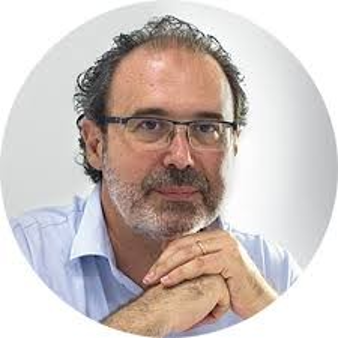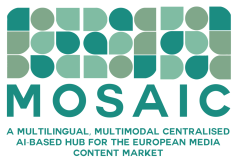Insights from Pangeanic CEO Manuel Herranz on the Transformative Impact of the EU Mosaic Project

The extremely diverse linguistic landscape of Europe has always been both our greatest cultural strength and a significant challenge for broadcasters. With 24 official EU languages and dozens more regional languages, European media organizations have long faced barriers in sharing content across borders. The EU Mosaic project exemplifies this shift, but its implications extend far beyond multilingual workflows. However, thanks to cutting-edge AI language technologies being pioneered through the EU Mosaic project, we stand at the threshold of a new era in multilingual broadcasting—one where AI not only streamlines production but can help redefine audience reach and engagement.
The Mosaic Project Breaks Down Language Barriers
The Mosaic project brings together major European broadcasters including RTV SLO (Slovenia), Deutsche Welle (Germany), 3cat (CCMA) from Spain, VRT from Belgium, and Sky Italia in a partnership to explore how AI language technologies can transform content creation and distribution workflows. The partners are public bodies except Sky Italia, also reflecting how technology can be tested and used in both sectors.
At its core, Mosaic aims to develop a unified approach to several interconnected technologies:
- AI Transcription: Converting spoken content to text with unprecedented accuracy
- Machine Translation: Adapting content across languages while preserving meaning and nuance
- Automatic Dubbing: Creating natural-sounding voiced content in target languages
- Content Management: Automatically classify content by image and video, creating useful metadata and descriptions
- Fake and Manipulation Detection: Automatically detect IA-generated content or content that has been tampered with
Together, these technologies promise to revolutionize how European broadcasters create, adapt, and share content across linguistic borders—but they also raise important questions about quality, cultural authenticity, and the changing role of human expertise.
AI Transcription: The Foundation of Multilingual Content
Accurate transcription forms the backbone of any multilingual content strategy. Traditional methods of manually transcribing broadcast content are prohibitively time-consuming and expensive, often taking hours of human work for each hour of content.
AI transcription systems being developed through Mosaic can generate accurate transcripts in minutes rather than hours, complete with:
- Speaker identification and diarization
- Automatic punctuation and formatting
- Timestamps for precise synchronization
- Recognition of specialized terminology
For broadcasters like RTV SLO and Deutsche Welle, this technology is already transforming news workflows, allowing journalists to quickly search through archived content, create accessible versions for hearing-impaired audiences, and prepare content for translation.
«What used to take our teams an entire day can now be accomplished in less than an hour,» notes a representative from the project. «This doesn’t just save time—it opens up entirely new possibilities for content sharing and archival research.»
Machine Translation: Beyond Word-for-Word
The limitations of traditional machine translation have long been obvious to anyone who has tried to translate subtitles or scripts between European languages. Idiomatic expressions, cultural references, and the natural rhythm of speech often get lost in translation.
The Mosaic project is developing context-aware translation systems specifically designed for audiovisual content that:
- Maintain consistency in terminology across programs
- Preserve stylistic elements and brand voice
- Adapt culturally-specific references appropriately
- Handle specialized vocabulary in news, documentary, and entertainment contexts
These advances are particularly significant for broadcasters serving multilingual regions, such as Belgium’s VRT and Catalonia’s 3cat, where content often needs to exist simultaneously in multiple languages.
Automatic Dubbing: The Next Frontier
Perhaps the most ambitious element of the Mosaic project is its work on automatic dubbing—the creation of natural-sounding voiced content in target languages. While still developing, these systems combine several technologies:
- Voice synthesis that captures emotional tone and emphasis
- Lip synchronization for visual content
- Preservation of original performance nuances
- Adaptation of timing to match target language patterns
For organizations like Sky Italia, which regularly adapts content from other European markets, these technologies could dramatically reduce production timelines while making more diverse content available to audiences.
The Human Element: Augmentation, Not Replacement
Despite the impressive capabilities of these AI systems, the Mosaic project emphasizes that these technologies are designed to augment human expertise, not replace it. Much like the debate around literary translation discussed recently in publishing circles, audiovisual content requires cultural understanding and creative judgment that AI alone cannot provide.
The most effective implementations being tested through Mosaic use AI as a first pass, with human experts providing critical oversight:
- Journalists verify transcription accuracy for news content
- Professional translators review and refine machine translations
- Voice actors supervise and enhance automatic dubbing
This collaboration between AI and human expertise creates a «best of both worlds» scenario—dramatically improved efficiency without sacrificing the quality and cultural authenticity audiences expect.
Content Management: Unlocking the Value of Visual Media
Beyond language processing, the Mosaic project is developing sophisticated tools for image and video analysis that transform how broadcasters manage their visual content. These technologies automatically classify and describe visual media, creating valuable metadata that makes content more searchable and accessible. Infalia, one of the technical partners in the Mosaic project, has showcased impressive capabilities for visual content management:
– Image annotation that automatically generates descriptive metadata
– Advanced search functionality for visual assets
– Export capabilities that streamline new content creation
For broadcasters like RTVSLO and 3cat, these tools offer tremendous advantages in managing vast media libraries. Content that was previously difficult to categorize or search can now be automatically indexed based on visual elements, making archives more valuable and accessible. «The ability to quickly find relevant visual content across our entire library can change how we approach production,» notes a project participant: «What used to require manual tagging and cataloguing may now happen automatically, unlocking new value in our existing assets.» The platform also enables collaborative workflows through workspace management, allowing broadcasters to create dedicated workspaces and invite third parties to collaborate on content. This collaborative approach extends to technical integration, with technologies from various partners being integrated into a common platform.
Fake and Manipulation Detection: Preserving Trust in Media
Perhaps most crucial in today’s media environment is the Mosaic project’s focus on content verification and authentication. With the proliferation of AI-generated and manipulated media, broadcasters face unprecedented challenges in maintaining audience trust.
The technologies that Mosaic makes available offer powerful tools for content verification, capable of:
– Detecting AI-generated images
– Identifying manipulated visual content (e.g., through photo editing software)
– Verifying the authenticity of image sources
– Analyzing video for signs of manipulation, with specific focus on faces and backgrounds
While these technologies continue to evolve—with models being updated and fine-tuned specifically for the Mosaic project—they represent a critical step forward in helping European broadcasters maintain the integrity of their content.
For organizations like Deutsche Welle and VRT, which operate in increasingly complex information environments, these verification tools provide essential safeguards against inadvertently spreading manipulated content.
«The ability to quickly verify the authenticity of visual media is no longer optional—it’s essential to our mission as trusted information providers,» explains a project representative. «These tools give us an additional layer of protection in a rapidly evolving media landscape.»
New Opportunities for European Broadcasting
The innovations being pioneered through Mosaic open several exciting possibilities for European broadcasters:
1. Content Exchange at Unprecedented Scale
Broadcasters can now realistically consider sharing significantly more content across language boundaries. News items, documentaries, and even entertainment programs that would previously have been limited to their original language markets can find new audiences throughout Europe.
2. Preserving Smaller Languages
For broadcasters working in languages with smaller speaker populations, these technologies offer a lifeline. Content created in languages like Slovene, Catalan, or Flemish can be more readily adapted for broader European audiences, while international content becomes more accessible to these communities.
3. Responsive Multilingual News Coverage
When breaking news occurs, the ability to quickly translate and voice content in multiple languages means European audiences can receive timely updates regardless of where events take place or which broadcaster first reports them.
4. Archive Activation
Decades of valuable broadcast archives that have been linguistically isolated can now be transcribed, translated, and made accessible to researchers, educators, and audiences across Europe.
Challenges and Ethical Considerations
The Mosaic project acknowledges that these powerful technologies come with responsibilities. Partners are actively addressing several challenges:
- Quality Assurance: Developing frameworks to ensure AI-generated content meets broadcast standards
- Transparency: Creating guidelines for disclosing when content has been automatically translated or dubbed
- Fair Compensation: Ensuring that efficiency gains don’t undermine the livelihoods of translators, voice actors, and other language professionals
- Cultural Sensitivity: Building systems that recognize when certain content requires more human oversight to preserve cultural nuances
Looking Ahead: The Future of Multilingual Broadcasting
As the Mosaic project enters its next phases, participants are focused on moving these technologies from separate, siloed implementations to production-ready interconnected systems. The goal is not to completely automate language processes, but to create flexible workflows where AI and human expertise complement each other.
«What we’re building isn’t just about efficiency,» explains Manuel: «It’s about creating a more connected European media landscape where stories and perspectives can flow more freely across language boundaries. That’s good for broadcasters, good for audiences, and good for European cultural exchange.»
For European broadcasters facing budget pressures while serving increasingly diverse audiences, the technologies being pioneered through Mosaic offer a compelling vision of the future—one where language differences become bridges rather than barriers, and where the vast richness of European voices becomes accessible to all.
